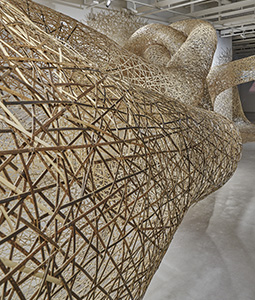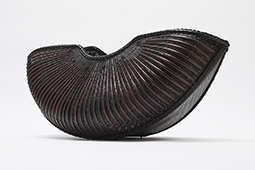August 2022
- English
- 日本語
A Craftsman Who Creates Huge Installations with Bamboo

LIFE CYCLES exhibited at the Japan House in Los Angeles, the United States (47m x 11.6m x 4m) 
CONNECTION-GODAI exhibited at Odunpazari Modern Art Museum, Eskişehir, Turkey (8m x 5m x 8m)

Tanabe Chikuunsai IV 
Close-up of the kikko ami (turtle shell knitting) technique used for LIFE CYCLES 
High Sail: Boat-shaped flower basket (60.5cm x 26.5cm x 28cm)

Bamboo craftsman Tanabe Chikuunsai IV creates huge contemporary art works using bamboo both in Japan and abroad, conveying the wonder of bamboo and exploring new possibilities for the material.

“LIFE CYCLES | A Bamboo Exploration with Tanabe Chikuunsai IV,” an exhibition about the bamboo craftsman Tanabe Chikuunsai IV, is being held at Japan Housei in Los Angeles, the United States, from July 28, 2022 to January 15, 2023. In addition to delicate crafts using bamboo, Tanabe and his four apprentices spent about three weeks at the venue for the display of a huge installation called “LIFE CYCLES” that they completed by hand. It is a structure consisting of about 11,000 bamboo strips, 47 meters in length, extending from wall to wall while twisting like a tornado. It overwhelms the viewer through its abundant dynamism and energy.
“I make the installation by sharing what I feel there and then with my apprentices, and in doing so, it becomes a ‘living’ work of art,” says Tanabe. “I've made about fifty of them in Japan and overseas, but I feel that this one is the most complete.”

Tanabe is the fourth generation of a line of bamboo craftsmen who have been working in Sakai City, Osaka Prefecture for about 120 years. After graduating from the Department of Sculpture, Faculty of Fine Arts, Tokyo University of the Arts, he studied bamboo craft techniques for two years at the Oita Prefectural Bamboo Craft Training Center in Beppu City, Oita Prefecture. Later, he further improved his skills under his father, Tanabe Chikuunsai III.
Having become a bamboo craftsman, Tanabe has made use of techniques that have been handed down from generation to generation, such as kikko ami (turtle shell knitting) with its hexagon meshes, while also producing bamboo crafts and artworks with contemporary designs. His work gradually came to attract attention overseas as well, and work by him exhibited at the Philadelphia Museum of Art Craft Show in the United States was purchased by the museum and made part of its collection in 2001. Since then, there have been exhibitions at the Museum of Fine Arts, Boston, and the British Museum in the United Kingdom, with works increasingly being purchased by overseas museums and art collectors.

As he expanded his activities both in Japan and abroad, Tanabe began working on installations. Since exhibiting his first work at an art museum in Osaka in 2012, he has been producing works in the United States, France, Brazil, Turkey and other countries.
“Bamboo is a material that has suppleness and purity as well as strength. I thought that by creating large-scale contemporary artworks, I would be able to convey the wonder of bamboo to more people,” explains Tanabe. “The good news is that many people of all nationalities and ages enjoy my installations. At Japan House, the production process was open to the public, and there were even elementary school students watching us very intently.”
Tanabe reuses bamboo strips from dismantling his work after an exhibition to make his next work. Works knitted with turtle shell knitting are very sturdy, but since no adhesive is used, they can easily fall apart. Every time he produces a work, about 10% of the bamboo strips deteriorate and break, so he adds new ones every time that happens.

“It is sustainable art that can only be made from natural materials,” says Tanabe. “When we dismantle this work at Japan House in January 2023, we plan to have locals help us out. Bamboo strips unraveled by Americans will be used to make a work in the next country, which is then unraveled by people in that country. Being able to make these kinds of connections is also part of the appeal of this installation.”
Tanabe’s work is also imbued with a strong desire to preserve Japanese bamboo-related industries and traditions. Currently, demand for Japanese bamboo is shrinking, and the people engaged in the maintenance of bamboo forests are aging more and more. Through his work, Tanabe has sought to stimulate demand for bamboo, create employment opportunities, and otherwise support sustainable conservation and utilization of bamboo forests. Moreover, through his production of installations, he is trying to pass on bamboo craft techniques to his apprentices and the next generation.
“Right now, the maximum height of my work is about 12 meters, but in the future, we will use new techniques and work with more people to create larger works that exceed 20 meters in height,” says Tanabe.
By creating innovative works and also preserving bamboo craft traditions, Tanabe is exploring new possibilities for bamboo.
* See Highlighting Japan June 2018, “Japan’s New High-Profile Cultural Outposts” https://www.gov-online.go.jp/eng/publicity/book/hlj/html/201806/201806_09_en.html

